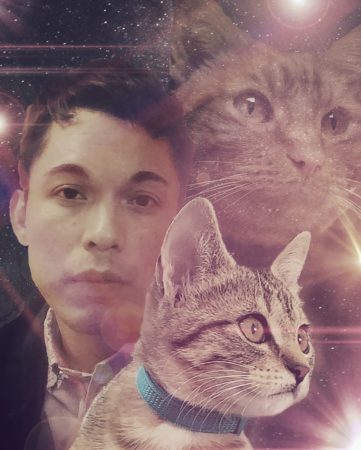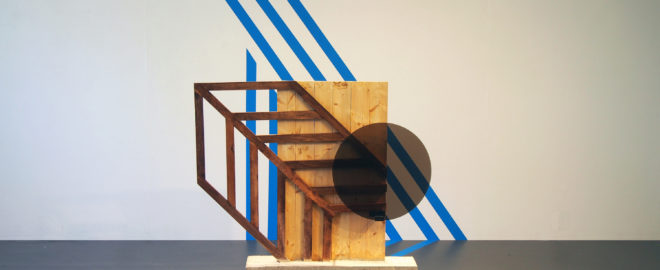Multi-media artist Pete Hoffecker Mejía assembles patterns from Latin America, retail and home décor motifs, and modernist geometric abstraction to explore the intersection of contrasting cultural influence, the mediation of identity, and conflation and caricature in the representation of otherness. His structures investigate the blurred points of contact resulting from estrangement, while also looking at hierarchies of representation and the continuing impacts of colonialism.
Born in Bogotá, Colombia, and raised in the United States, Hoffecker Mejía received his BFA from the University of Memphis and an MFA from Indiana University. His work has appeared in print and online magazines including New American Paintings and Peripheral Vision Press. He has been an artist-in-residence at the Kimmel Harding Nelson Center for the Arts, the Studios at MASS MoCA, the Vermont Studio Center, and others.
“I am expressly concerned with exploring intersections and in-between spaces, and in examining whose voices are included in the histories of formalist gestures and whose are excluded.”
 Q&A with Pete Hoffecker Mejia (from Crosstown Arts newsletter, Jan. 11, 2022)
Q&A with Pete Hoffecker Mejia (from Crosstown Arts newsletter, Jan. 11, 2022)
Crosstown Arts residency alumnus Pete Hoffecker Mejia’s work is engaged in the exploration and mediation of intersectional cultural identity, hierarchies of representation, and the politics of abstraction. His structures investigate the blurred points of contact resulting from estrangement, while also looking at the continuing impacts of colonialism.
Born in Bogotá, Colombia and raised in the United States, Hoffecker Mejía received his BFA from the University of Memphis and an MFA from Indiana University. His work has appeared in magazines such as Create! and New American Paintings. He has been an artist-in-residence at the Studios at MASS MoCA, Ox-Bow School of Art, the Vermont Studio Center, and others. He is currently Assistant Professor at Western Oregon University.
Crosstown Arts registrar Jesse Butcher caught up with Hoffecker Mejía to discuss his transition from painting to sculpture, his artistic process, and how his love for music has influenced his visual practice.
Jesse: Your initial visual practice was painting. What inspired the transition into a sculptural- and installation-based practice? Were the paintings also inspired by modernist geometric abstraction?
Pete: The paintings themselves bore little resemblance to my current work. I was gifted a still image projector by a friend and started using it to paint some collage-based works. I have always been a collector, and I used the projector to combine the imagery from old magazines, album covers, manuals, and assorted printed ephemera. I am making it sound better than it was! It did involve a great deal of layering and flat color with hard edges, which carried over in the more sculptural works.
The transition to fabricating sculptural objects, rather than paintings came pretty late. It was really a result of exposure. I didn’t even think of sculpture as an option until I started college. I have a strong interest in history, and the ability to bring in found objects to the work that carried their own histories was really appealing to me. It also just seems more expedient. I am not the best painter in the world, but I like composing through arrangement. This comes easier to me with an object.
I also have some misanthropic tendencies, and I kind of like that no one can talk to you when you are operating machinery. They can, however, still talk to you when you are making a painting. Take heed, fellow introverts!
My attraction to geometric abstraction is mainly because of its proximity to other geometric works I had digested. I was always intrigued by the distance it creates to work with abstract geometries. Like how do I read this? What does a red square mean? The signs often seem disconnected. I do not find any sort of modernist order or clarity. I see uncertainty and ambiguity, even an anxiousness. I see a real crisis in geometry which I find particularly appealing.
Your mother was employed by a convent and produced textiles. How has her own history with weaving influenced your interest in fiber and material studies?
Both of my mothers (adoptive and biological) have a history with textiles. I also grew up surrounded by mostly woven items from Colombia and Latin America. The material, and its imagery, was deeply important to me in that they felt like a closed point of access to deeply personal information — a strong mixture of warmth and cold. I probably put a lot of my early feelings of estrangement into those objects. That kind of diasporic longing is present in my treatment of forms today, as is the idea that objects can be encoded with cultural information and also deculturated. I also think the aspect of making something inviting but also restrictive is an outcome of these experiences.
My interest in materiality is informed by personal histories and social histories. I think there is a contrast between what some concerned with geometric abstraction would think of as universal and elements like weavings, that are more regional or local. Likewise, there is an exploration of the contrast between what is thought of as “craft” and shows the work of hands, and what is not, such as laser-cut plexiglass, which is devoid of the hands trace.
You have spoken about the works as a “space of meditation.” How important is the spatial dynamic of the work and its presentation to the creation of a work? Do you feel some of the works are site-specific or do they become malleable and informed by the history of the places where that they are displayed?
I refer to it most often to it as a space of mediation. It is a space where I can reflect on the double consciousness or two-ness of being, aware of the caricature, compression, and romanticization of Latin-American culture and indigenous cultures. It is a place where I explore and negotiate contrast. It is also partially driven by not seeing myself in the academic studies of visual art. As artist and theorist John Akomfrah recently said about art history, “that very thing you love may also be that thing which is keeping you in a state of discomfort, so you have to find another way of coming at it by embellishing it with other stories and other narratives.” I feel like his statement is more succinct than I could put things. This is reflected in my teaching, which seeks to decenter the traditional canon in favor of a more inclusive environment.
An interest in geometric abstraction breathes through these works with the will toward and denial of the grid. What is the process like for beginning a sculpture? Do you start by selecting materials, finding an object, making a sketch? Do you find the color palette to be pre-determined, or does that develop itself through the layering and opacities as you construct?
I would say that the works most often begin with an object. That object informs the rest of the work. It is a bit of a call and response. I do utilize drawing early on, sometimes digital rendering, but the actual fabrication process is still fairly intuitive. I am conscious of color and usually gravitate towards plastic, bright, often slightly unnatural color. As in other parts of the work, I am especially interested in contrast, and that informs my decision-making as well.
As far as the grid, it is omnipresent. It is in everything — our architectures, electronics, our prison system (as Peter Halley famously explored), our treatment of the land, and ideas of progression, development, and access. I am drawn to it and repelled by it. The most recent works at Tri-Star Arts have a stronger adherence to the grid than some previous pieces. Like the grid, I have a strange relationship with the idea of a frame. It is a nice constraint, working against or with it can be a generative process, but it is corralled, and often controlling.
Music was prominent in your upbringing, and you have released records under the monikers “Girl Party” and “Megalon Esquire.” I’m interested in how your passion for music has potentially influenced your visual practice.
My family are orchestral musicians. I was always around music growing up. As a child, they would bring me to the rehearsals, and I was always exploring old empty music halls and theaters. I sometimes work in sample-based music production, and this is very much akin to found object sculpture. The 4/4 signature and other formal constraints are like the visual grid; the audio sample itself is a found object. The works are a combination of the pre-existing and the newly fabricated. The process of looking for snippets and fragments to reconstitute into a whole is an essential part of sample-based beat production. I think there is a similar ethos in my own work of utilizing what is around and the impulse to deconstruct and reconstruct. Music is a deep love, and my early dabbling in creative music is what gave me the license to experiment and improvise.
It was great catching up with you Pete. We are looking forward to following your practice as it continues to develop!

